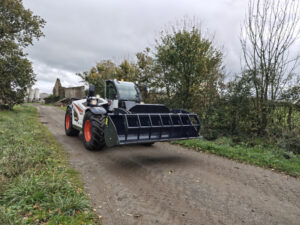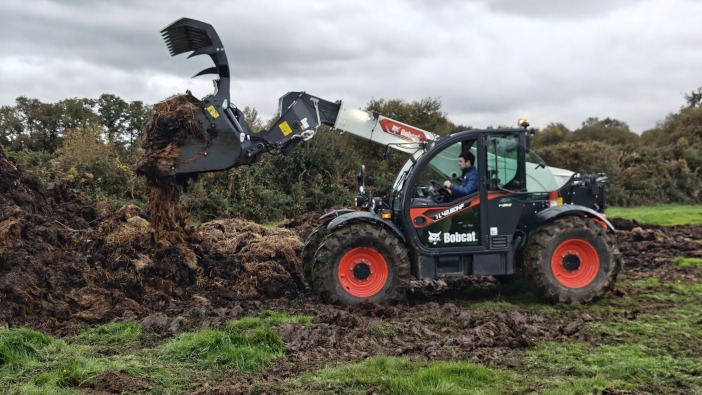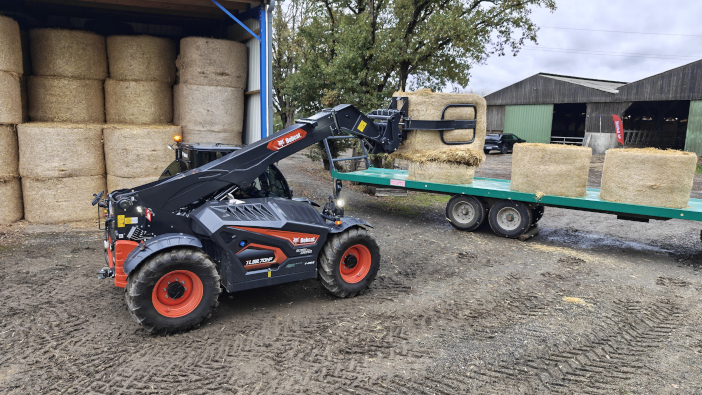A trip to Pontchâteau to hear about a new limited edition specification gave us the chance to put the company’s V-Drive transmission through its paces
It’s been 25 years since Bobcat purchased French manufacturer Sambron and entered the telehandler market. Now the Pontchâteau factory produces the telehandlers for the global market, currently producing 2,400 each year, split evenly between agriculture and construction, with a production capacity of around 4,000 machines. Around 400 agricultural telehandlers are produced for Massey Ferguson each year at present.
The factory itself sits over 14,000sq m, on a 82,000sq m site, with 1,500sq m of warehousing, holding more than 5,000 parts from 250 suppliers; the bulk of which are based in Europe. A total of 300 people are employed on the site, with 250 working in production. The welding bays and paint shop work in two shifts, with the main production line only doing one shift to produce 13.5 machines per day. At peak production, a third shift is added for welding and painting.
Each machine is built to order, with steel delivered already cut, going through a new hydraulic press and tack-welded manually, before going through the robotic welders. Some boom and chassis frames are produced for stock, just so peaks in production can be addressed quickly.
Frame and boom assemblies are shot blasted and painted before joining the single production line. Sub-assembly setups are used to feed into the main line, enabling the company to adhere to lean manufacturing practices. Once through production, every single machine goes through a two-hour quality control phase, incorporating both static and moving tests.
 The agricultural portfolio
The agricultural portfolio
Bobcat’s agricultural telehandlers are split into three platforms, with ten models across each frame size. The Super Compact offers a lift capacity of 2.5t and a maximum vertical reach of 5.9m, powered by a 75hp Hyundai Infracore engine, part of Bobcat’s parent company. It’s designed for operation in small areas, including traditional sheds, with its width and height both coming in under 2m.
The Compact range has two models, both with a 3t capacity, lifting to either 5.8m or 6.7m. It has a 100hp engine and can be optioned with a low cabin for working indoors. The large frame models have a variety of choices. The entry TL34.65 High Flow (HF) model offers 3.4t of lift capacity, with a lift height of 6.3m. This can also be specified with the continuously variable V-Drive transmission.
There are two 7m models, offering lift capacities of 3.5t or 3.8t, the latter of which is also available with the HF specification and the V-Drive system. Finally, the flagship TL43.80HF offers 4.3t capacity and lifts to 7.5m, with the option of the V-Drive gearbox.
The V-Drive is manufactured by Linde, but with Bobcat reportedly heavily involved in the development. It’s suspended within the frame to limit vibrations and noise, and is split into two stepless hydrostatic ranges, with the ability to shift between them on the fly, as well as between forward and reverse.
With the stepless transmission, various systems have been integrated into the machines, including cruise control, with the ability to adjust the speed during work using the rollers on the joystick. A speed limiter is included, which can be activated from the cabin for greater control during loading or movement tasks, or set behind a passcode to stop younger operators from going above a certain speed.
The co-development with Bobcat means that it works in tune with the Hyundai engine, enabling Stop & Start, which can be set to kick in after the machine idles for between one and 20 minutes. Eco Ride is also featured, which automatically adjusts the engine speed to provide the most economical fuel consumption possible based on the hydraulic use and ground speed.

Jumping in the cab
There were three V-Drive machines available for us to put to the test. The first was TL38.70HF, which was just used for roading, enabling us to see how the boom suspension worked and enable us to get a feel for the transmission.
The cab is nicely laid out and comfortable, with good visibility all round, even to the right-hand side when the boom is lower. The transmission is easy to use, literally just put your foot on the pedal and go, and the bounce from the boom was dampened thanks to the suspension system. Despite the track being rather bumpy, the driver’s seat felt isolated from this, and the four-wheel steer gave the machine a tight turning circle – with the bonus of a reversing camera on the odd occasion that we did have to shift directions.
We could also confirm that the speed limiter worked well, keeping us below 20kph, which the machine quickly accelerated to. Unfortunately, we weren’t given the code to unlock this.
There was only one complaint on the road experience, and it’s one that is ubiquitous across the sector. Despite having a 40kph top speed, the machine will not automatically kick out of four-wheel steer. Given the industry’s poor health and safety record and the fact that operators of all experience levels are working long hours, often under pressure, I would assume that this would be an obvious addition, and not just to the Bobcat range.
 Moving on and we set about shifting round bales from a trailer to the shed, and vice versa, with another TL38.70HF in the new black specification (see box). Here, we were given the chance to test the upper and lower boom height limits, which were simple to set up and use. After extending the boom to the desired height, you hold down a button on the right-hand console until you hear a beep. You can do the same with the lower limit as well. Once these are set, you use the joystick as normal.
Moving on and we set about shifting round bales from a trailer to the shed, and vice versa, with another TL38.70HF in the new black specification (see box). Here, we were given the chance to test the upper and lower boom height limits, which were simple to set up and use. After extending the boom to the desired height, you hold down a button on the right-hand console until you hear a beep. You can do the same with the lower limit as well. Once these are set, you use the joystick as normal.
The boom will stop lifting or extending as soon as the maximum height is reached, and will retract the boom during the lowering process to reach the lower limit.
The hydraulics are fast-acting, and by automating some of the repetitive motions, we could load and unload without concerns about dinging either the shed or the trailer.
Our final test of the machine was in a wet field, with a muck heap that needed pushing up. Here, the TL43.80HF impressed with the torque and grip. Despite the conditions, we were able to keep pushing the heap, grab a full fork of manure and reverse back onto the grass. There’s a weight monitor on the A-pillar which showed the balance of the machine, but when this was reached ,the boom came to a gentle stop, rather than jolting and losing half the load.
By the end, we were thoroughly impressed with the V-Drive models. It matches up to pretty much everything on the market, especially in the field, where the power and responsiveness made it easy to handle the well-rotted muck. There are some niggles, but nothing that’s exclusive to Bobcat, and the ease of setting up the smart boom features meant that we could just get on with the task at hand.


